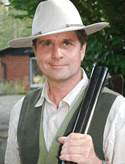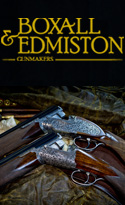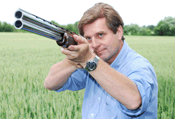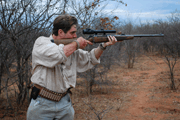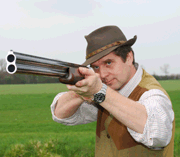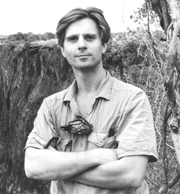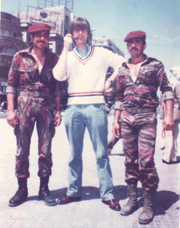Shooting Style
There was a time when shooting style – or shooting ‘form’ as it is sometimes called – was taken rather more seriously than it is today. It is a bit like skiing, I can remember when the goal on piste was to keep legs locked together and ‘weddel’ down the mountain smoothly in a series of wonderfully elegant snake-like turns (preferably in very tight pants using very long skis). Now, we have shortened our skis, opened our legs in imitation of Franz Klammer, wear jeans, toddler suits, puffy anoraks or gorilla costumes and let it all hang out. Getting to the bottom of the hill and in one piece is the only goal. It does not look as chic, but the technique is arguably more stable unless one adds a backward somersault or two into one’s repertoire.
In shooting, happily, we retain better dress codes (usually). I still believe, moreover, that the old, defined, shooting styles with a little modification are both the most beautiful to watch and still the most efficient and safest means to grass birds. Regular readers may know that I regard myself as an instructor in the Stanbury school. His bowed body position for an incoming, high, driven shot, is instantly recognisable. It is elegant, controlled and extremely effective. The weight stays forward and on the left foot (assuming a right-hander) for nearly all shots. This allows one to pivot on the front foot effectively and keeps the head down.
When waiting for a bird, Stanbury’s wonderful style requires that the back is kept relatively straight, (it arches with the rest of the body for the driven shot as described above). Beginners tend to arch the back excessively from the start of the shooting process and bring the weight back in reaction to the unfamiliar mass of the gun. They end up lifting their heads and losing balance as a result. Some experienced shots, on the other hand, tend to lean too far forward. This helps to control recoil to a degree, but impedes an efficient swing.
The correct address position for most people (nothing is absolute in shooting style bar safety) is for there to be a straight line relationship between the front shoulder, front hip and the ball of the front foot. This will require the un-weighting of the rear heel. One alternative, and one I frequently adopt when birds are challenging, is to wait with a squarer stance and to step into the classic 1 o’clock and 3 o’clock stance as one makes the decision to engage a bird to the front. I find this may introduce a little extra momentum into the swing.
Some people, it may also be noted, may prefer a more natural shooting stance, with centre of gravity further rearward (but, not necessarily between the feet). I have nothing against this more modern approach provided it creates a stable shooting platform and allows one to keep one’s head down during swing, shot and follow through. Good shooting style – and it is recognisable in different forms – always provides good balance at the critical moment as the shot is taken.
Standbury’s method has the feet set not too far apart (6-9 inches or so assuming a man of normal build) and the front leg straight. Robert Churchil advocated an even closer straight leg stance and a suggested a weight transference depending on the shot – onto the right foot for the shot to the right and onto the left foot for the shot to the left. There has been much argument about the wisdom of this.
I have developed the technique of turning into the bird’s line as a supplement to the Stanbury method. One should step into the line of the bird whenever possible anticipating its killing point. I ideally like to have my rear foot at about 90 degrees to where I want to kill the bird. This is not always possible. Sometimes, one must rely on rotation alone or adopt Churchill’s weight transference. When I move the feet as part of an evolved/modified Stanbury system, however, the front foot and barrels move together as if connect by an invisible wire. The step into the line with the front foot is a small one, moreover. The front foot leads and the rear foot naturally rotates on its ball to bring one back to a classic 1 o’clock and 3 o’clock relationship to the anticipated killing point.
When I have completed the step into line and the shot itself, I automatically return to centre, reload if time permits, and adopt an address position which is forward facing as normal – eyes scan above or through the top if the muzzles to my front. So, the basic routine begins from a normal forward facing address and returns to it once the shot is taken. I tend to be quite mechanical about this. This may be an area for improvement, but I find that by being a bit of an automaton that I do not forget any fine points of stance – I remember to keep the weight slightly forward and do not get caught wrong footed. I am similarly quite mechanical, or if you prefer, careful about picking up the line of any incoming bird. I do not trust to chance. Some are blessed with better natural ability and do not need to operate to such a conscious plan.
Churchill did not advocate the swing through technique which is often associated with Percy Stanbury (it is, in fact, a much earlier invention). Churchill’s instruction was to point the gun – preferably a short barrelled one – instinctively and seemingly at the bird having learnt a series of drills. His technique – and you will find more about it his books Gameshooting and How to Shoot - has its uses, but it can result in a controlled poke even when carried out to the letter and does not suit high birds as well as swing through in my experience.
Whilst considering techniques of forward allowance, let me note that there are different ways that one may swing through. Everything from a wild swing starting yards behind the bird and off its line of it to a much more controlled action – one led by the front hand bringing in the barrels just behind or on the tail feathers of the bird and perfectly up on its line. This is usually my aesthetic and practical preference. However, after much recent experiment, I have found that high birds seem to be shot most effectively when one starts with the muzzles some two or three yards behind. With closer birds, I am much more instinctive. I may even become a Churchillian if something takes me by surprise on the right flank (i.e. I may then transfer the weight to the right foot and shoot instinctively).
What about maintained lead? It presents dangers both of missing in front and of stopping. The same set of experiments which led me to discover that a point of insertion some way behind a driven bird seems to be the most effective form or swing through at range, also led me to conclude that to maintain a lead deliberately (measuring a lead) or instinctively also created the tendency to stop once the trigger was pulled. I would now risk saying, therefore, that shooting with an accelerating gun is another important and near universal aspect of good shooting style. This may be over done, however, as is the case with those who have developed the tendency to flick at the end of the shot because they have not learnt to use their core body motions to power the swing. The acceleration must be part of one smooth action that brushes the bird out of the sky.
Good timing is another prerequisite of good shooting that is not specific to any particular method. There are occasional exceptions (as to everything as noted) but the good shot usually operates to three beats. He (or she) does not point and slash to two. The gun is not be mounted too early, nor does it dwell in the shoulder too long – both may be considered absolute errors of style. Being out of balance, as noted, is another cardinal sin – however else one may shoot, you must be stable as the trigger is pulled otherwise you cannot complete the shot properly.
The good shot always has fluency of action and usually, there are some notable exceptions, appears unhurried. Many excellent shots have a decisiveness about their actions, as well, they appear to have a gift of anticipation. This is because the watch carefully and note where the bird is going and react/prepare themselves accordingly. They also look as if they mean business, it is as if there is nothing between them and the bird once they are committed to the shot. They are certainly not impeded by neurotic thoughts. Once committed to what is judged to be a safe shot, the safety is removed, and they engage and kill the bird in one flowing motion. Concentration is absolute, but, paradoxically, relaxed. All physical and mental focus is on the bird, or its head or beak.
Good shots have also learnt to finish the shot well. They don’t immediately lift their head or detach themselves from the stock as the trigger is pulled. They follow through as in tennis, cricket, or golf. Even some experienced shots tend to prematurely unlock their head and shoulder from the gun. This not only looks inelegant – in that it can appear a bit out of control – but it prevents a smooth follow through (which of itself ensures not only that the gun keeps moving but that the head stays on the stock).
With regard to the earlier phase of the gun mount, good shots do not let the rear hand dominate the mount, they control the tip of the gun by good use of the front hand. Most people in my experience do not use the front hand enough (probably because it is weaker) yet, its role in shooting is critical. It lifts the gun, points the muzzles and completes the follow through. In my vade mecum effective use of the front hand is high on the list of priorities.
Some excellent shots of the old school extend their front hands too far forward. They do this, whether they know it or not, in imitation of a fashion set by King George V. It looks quite elegant, and, it may help with controlling line, but, the far front hold may check the swing and cause a shoulder to drop and the line to be lost on crossing shots. I much prefer to see the front hand in a comfortable natural position about half way up an over under’s forend, or, on a side by side, ‘half wood-half steel.’ (i.e a bit more forward but not resting soley on the barrel). Those who have side by sides with beaver-tail forends, however, are probably best advised to adopt an over and under style hold mid-way on the forend.
So, what is good style? Well it is easy to say what isn’t – rushing, being off balance, tracking birds, and pushing out bottoms with bent knees all look awful. Good shooting style is not completely defined, but it is instantly recognisable. There is room for individualism. I’m not saying Percy Sanbury’s or any other way is the only way to shoot. That would be nonsense. But, there are common qualities to good style – control, balance, elegance and flow, as noted, not to mention economy of movement and a sense that the result is a foregone conclusion. It is often said of a good shot that one can see that the bird is dead before the trigger is pulled. This is because nothing is out of place, it is recognisable that everything is heading toward an inevitable conclusion. Is it better to miss with style that hit with none? Of course it is, because the person that has developed style has developed consistency as well. And, what is wrong with looking good into the bargain? Grace of form may not be a PC imperative, but it makes for a richer life.
For more on shooting style see Mike's new Natural Shooting DVD


